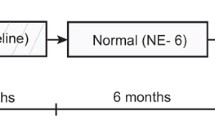Summary
The superior colliculus was removed from rats at either one or five days of age or in maturity. Four months later they were tested on two versions of a visual search task. Experiment 1 required animals to retrieve food pellets concealed in a depression in the top of identical narrow pillars arranged in an arena. Rats with lesions of the superior colliculus, regardless of the age at operation, showed a large number of ‘return’ errors compared with sham-operated controls. Return errors were defined as occasions on which the animal returned to pillars that had previously been visited on that trial, before every pillar had been visited at least once. Experiment 2 compared the ability of infantand adult-operated animals to detect and locate a single, baited white pillar in an array of black ones. There were no group differences in response latencies to targets presented in the rostral visual field (within 40° of the midline). However, animals operated on in adulthood or at 5 days of age were slower than both sham-operated animals and animals operated on at one day of age in their responses to more peripheral targets. The latter two groups were indistinguishable.
Similar content being viewed by others
References
Collin N, Cowey A, Latto R, Marzi C (1982) The role of frontal eye-fields and superior colliculi in visual search and non-visual search in rhesus monkeys. Behav Brain Res 4: 177–193
Cowey A, Perry VH (1982) Degeneration and regeneration in rats following early or late damage to visual pathways: their relation to visual acuity. Documenta Ophthal Proc Series 30: 169–176
Dean P, Key C (1981) Spatial deficits on radial maze after large tectal lesions in rats: possible role of impaired scanning. Behav Neural Biol 32: 170–190
Goodale MA (1982) Neural mechanisms of visual orientation in rodents: targets versus places. In: Hein A, Jeannerod M (eds) Spatially oriented behaviour. Springer, Berlin Heidelberg New York
Goodale MA, Foreman NP, Milner AD (1978) Visual orientation in the rat: a dissociation of deficits following cortical and collicular lesions. Exp Brain Res 31: 445–457
Heywood CA, Cowey A (1985) A comparison of the effects of superior collicular ablation in infant and adult rats. Exp Brain Res 59: 302–312
Heywood CA, Cowey A (1986) The nature of the visual discrimination impairment after neonatal or adult ablation of superior colliculi in rats. Exp Brain Res 61: 403–412
Ingle D (1982) Organization of visuomotor behaviors in vertebrates. In: Ingle D, Goodale M, Mansfield R (eds) The analysis of visual behavior. MIT Press, Cambridge, pp 67–109
Kalil K, Reh T (1982) A light and electron microscopic study of regrowing pyramidal tract fibres. J Comp Neurol 211: 265–275
Linden R, Cowey A, Perry VH (1983) Tectal ablation at different ages in developing rats has different effects on retinal ganglion cell density but not on visual acuity. Exp Brain Res 51: 368–376
Perry VH, Cowey A (1979) Changes in the retino-fugal pathways following cortical and tectal lesions in neonatal and adult rats. Exp Brain Res 35: 97–108
Schneider GE (1967) Contrasting visuomotor functions of tectum and cortex in the golden hamster. Psychol Forsch 31: 52–62
Schneider GE (1969) Two visual systems:brain mechanisms for localization and discrimination are dissociated by tectal and cortical lesions. Science 163: 895–902
Schneider GE (1970) Mechanisms of functional recovery following lesions of visual cortex or superior colliculus in neonate and adult hamsters. Brain Behav Evol 3: 295–323
Schneider GE (1973) Early lesions of superior colliculus: factors affecting the formation of abnormal retinal projection. Brain Behav Evol 8: 73–109
Schneider GE (1979) Is it really better to have your brain lesions early? A revision of the “Kennard principle”. Neuropsychologia 17: 557–583
Schneider GE, Jhaveri SR (1974) Neuroanatomical correlates of spared or altered function after brain lesions in the newborn hamster. In: Stein DG, Rosen JJ, Butters NN (eds) Plasticity and recovery of function in the central nervous system. Academic Press, New York, pp 65–109
Tsang Y-C (1934) The functions of the visual areas of the cerebral cortex of the rat in the learning and retention of the maze. J Comp Psychol Monogr 10: (4, Serial No. 50)
Tsang Y-C (1937a) Maze learning in rats hemidecorticated in infancy. J Comp Physiol Psychol 24: 221–253
Tsang Y-C (1937b) Visual sensitivity in rats deprived of visual cortex in infancy. J Comp Physiol Psychol 24: 255–262
Author information
Authors and Affiliations
Rights and permissions
About this article
Cite this article
Heywood, C.A., Cowey, A. Effects on visual search of lesions of the superior colliculus in infant or adult rats. Exp Brain Res 65, 465–470 (1987). https://doi.org/10.1007/BF00236320
Received:
Accepted:
Issue Date:
DOI: https://doi.org/10.1007/BF00236320




